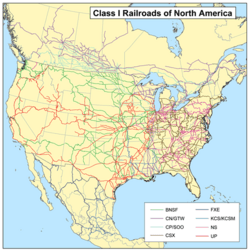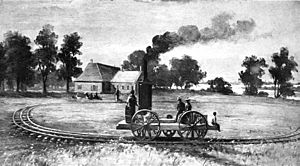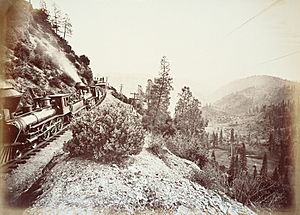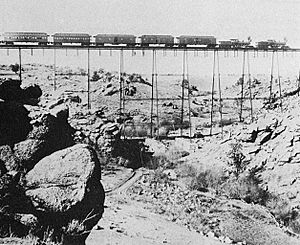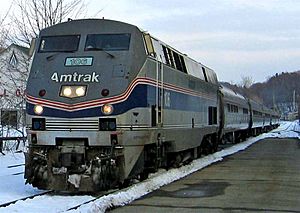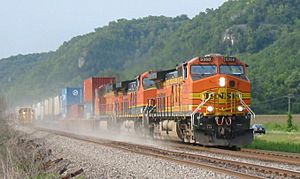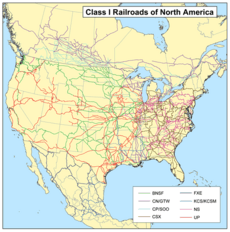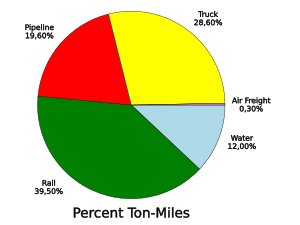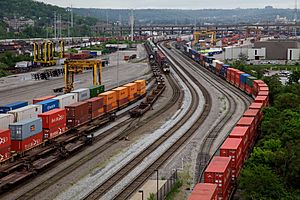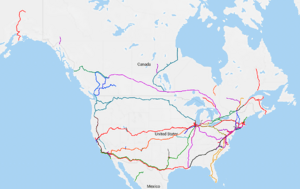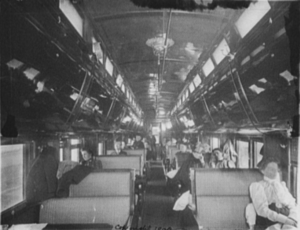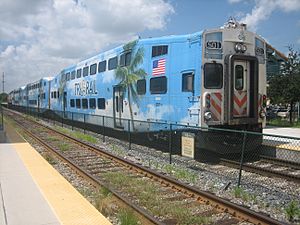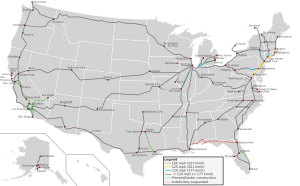Rail transportation in the United States facts for kids
Quick facts for kids Rail transport in the United States |
|||||||
|---|---|---|---|---|---|---|---|
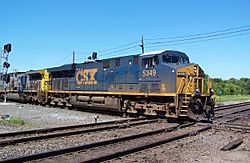
A CSX train at a diamond junction in Marion, Ohio
|
|||||||
| Operation | |||||||
| Major operators | Amtrak BNSF Railway Canadian National Railway Canadian Pacific Railway CSX Transportation Kansas City Southern Railway Norfolk Southern Railway Union Pacific Railroad |
||||||
| Statistics | |||||||
| Ridership | 549,631,632 29 million (Amtrak only) (2014) |
||||||
| Passenger km | 10.3 billion (2014) | ||||||
| Freight | 1.71 trillion ton-mile (2014) | ||||||
| System length | |||||||
| Total | 160,141 mi (257,722 km) | ||||||
| Track gauge | |||||||
| Main | 1,435 mm (4 ft 8 1⁄2 in) standard gauge | ||||||
| Features | |||||||
| Longest tunnel | Cascade Tunnel, 7.8 miles (12.6 km) | ||||||
|
|||||||
Rail transport in the United States mainly moves freight. It has a large network of private freight railroads. These railroads use a standard gauge (a specific track width) and connect to Canada and Mexico.
Passenger trains are mostly for mass transit and commuter rail in big cities. Long-distance passenger service used to be very important. Now, it plays a smaller role compared to other countries. The United States has the largest rail network in the world.
The first railroads in the U.S. were built in the 1820s and 1830s. They were mostly in New England and the Mid-Atlantic states. The Baltimore and Ohio Railroad, started in 1827, was the first public railroad. By 1850, a big rail network grew in the Northeast and Midwest. Fewer railroads were built in the agricultural South. After the American Civil War, the first transcontinental railroad connected California to the rest of the country in Iowa.
Railroads kept growing throughout the 1800s, reaching almost every part of the nation. The government took over railroads temporarily from 1917 to 1920 during World War I. This was when the total railroad mileage was at its highest. The Great Depression in the United States hit railroads hard, and some lines were closed. Traffic increased during World War II, but after the war, railroads faced strong competition. Cars and airplanes became very popular.
Passenger service suffered the most. In 1971, the government created Amtrak to handle long-distance passenger travel. Many railroad companies went bankrupt in the 1960s. The government stepped in again, forming Conrail in 1976. Conrail took over bankrupt railroads in the Northeast.
Things started to get better for railroads after the Staggers Rail Act in 1980. This law made rules for railroads less strict. New ideas like trailer-on-flatcar and intermodal freight transport helped traffic grow. Many railroads merged after the Staggers Act. Big companies like CSX, Norfolk Southern, BNSF Railway, and Union Pacific Railroad formed. Smaller railroads, called shortlines, also appeared. They took over lines that bigger railroads sold or stopped using. Freight railroads invested in new technology and improvements in the 21st century.
Contents
How Rail Transport Started in the U.S.
Early Railroads (Before 1850)
Between 1762 and 1764, a gravity railroad (a type of mechanized tramway) was built in Lewiston, New York. It moved goods up a steep hill near the Niagara River.
In the 1820s to 1840s, Americans watched how railways grew in Great Britain. Canals and steamboats were the main ways to transport goods then. The U.S. Army Corps of Engineers helped a lot. Their officers surveyed routes, designed tracks, and built structures. Many West Point graduates became leaders in railroad companies.
State governments gave special permits to railroad companies. These permits allowed them to buy land needed for tracks, even if the owner didn't want to sell.
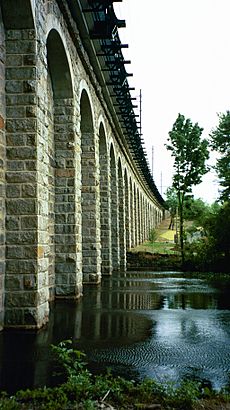
The Baltimore and Ohio Railroad (B&O) started in 1827. It aimed to build a steam railroad west from Baltimore, Maryland. It began carrying freight on May 24, 1830. The Lehigh Coal & Navigation Company was the first railroad to carry passengers, starting in 1827. It was a gravity road that moved coal downhill. Later, it became a tourist attraction.
The Mohawk & Hudson Railroad started operating in August 1831. The Saratoga & Schenectady Railroad began service in June 1832. In 1835, the B&O finished a line from Baltimore to Washington, D.C. The Boston & Providence Railroad was completed in 1835.
Many short lines were built, especially in the South. They connected to rivers and riverboats. The Pontchartrain Rail-Road in Louisiana was finished in 1831. It connected the Mississippi River to Lake Pontchartrain. The Tuscumbia, Courtland & Decatur Railroad was the first railroad west of the Appalachian Mountains. It connected two cities in Alabama.
The Camden & Amboy Railroad (C&A) was the first railroad in New Jersey. It connected its namesake cities in 1834. The C&A later became part of the Pennsylvania Railroad.
Growth and Expansion (1851–1900)
By 1850, over 9,000 miles (14,000 km) of railroad lines were built. The B&O reached the Ohio River in 1852. Railroads in the North and Midwest connected almost every major city by 1860.
Building the Transcontinental Railroad
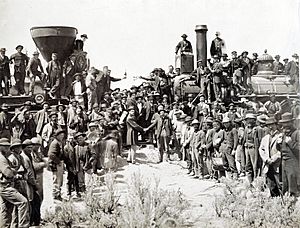
The First Transcontinental Railroad was built across North America in the 1860s. It linked the eastern U.S. railroad network with California on the Pacific coast. It was finished on May 10, 1869, in Promontory, Utah. This railroad created a nationwide transport system. It changed how people and goods moved in the American West.
The Pacific Railroad Acts of 1862 supported this project. The federal government heavily backed it. It was a major achievement during the time of President Abraham Lincoln. Building the railroad needed huge engineering and labor efforts. The Union Pacific Railroad built westward, and the Central Pacific Railroad built eastward. The railroad helped connect the country during the American Civil War. It also sped up the settlement of the West by homesteaders.
Much of the original track is still used today. It is owned by UP, which came from both original railroads.
Standardizing Track Width
Many early railroads in Canada and the U.S. used different track widths. But most were changed to standard gauge by 1886. This change, along with standardizing couplings and air brakes, allowed trains from different companies to use the same tracks.
How Railroads Changed the Economy
| Region | 1850 | 1860 | 1870 | 1880 | 1890 |
|---|---|---|---|---|---|
| New England | 2,507 | 3,660 | 4,494 | 5,982 | 6,831 |
| Middle States | 3,202 | 6,705 | 10,964 | 15,872 | 21,536 |
| Southern States | 2,036 | 8,838 | 11,192 | 14,778 | 29,209 |
| Western States and Territories | 1,276 | 11,400 | 24,587 | 52,589 | 62,394 |
| Pacific States and Territories | 23 | 1,677 | 4,080 | 9,804 | |
| Totals | 9,021 | 30,626 | 52,914 | 93,301 | 129,774 |
Railroads had a huge impact on American transportation in the late 1800s. They helped create a national market in the U.S. They also showed how to organize and manage large companies. Railroads allowed the American population to grow outside the eastern regions. They made it cheaper to transport goods and helped new products reach markets. This also boosted industries like coal, iron, and engineering.
Controlling Railroads
People like Cornelius Vanderbilt became very rich from owning railroads. Large railroad companies, such as the New York Central Railroad and Southern Pacific, spread across many states. Some railroads used unfair practices, like setting high prices. Because of this, Congress created the Interstate Commerce Commission (ICC) in 1887. The ICC set rules for railroads. Congress also passed antitrust laws to stop railroad monopolies. The first was the Sherman Antitrust Act in 1890.
Railroads in the 20th Century (1901–1970)
Mainline railroads focused on moving freight and passengers over long distances. Many also had local services near big cities. These services competed with streetcars and Interurban lines. Most Interurban lines failed during the Great Depression. This left many cities without local passenger trains. However, big cities like New York City and Chicago kept their local services.
Major railroads offered luxury trains for long journeys. These trains were like hotels on wheels. But they could not compete with airlines in the 1950s. Slow trains served rural areas. They survived until the 1960s because they carried Railway Post Office cars. The U.S. Post Office paid for these. When mail sorting became automated, these services stopped.
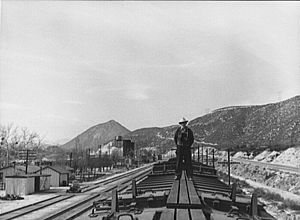
By the 1930s, cars started to reduce rail passenger numbers. The growth of the Interstate Highway System and commercial aviation in the 1950s and 1960s hurt rail transport even more. Strict rules also made things harder for railroads. There was little reason to run passenger trains when freight customers traveled by car or plane.
Soon, passenger trains only ran because of legal rules. Railroad companies wanted to get out of these rules. It seemed like long-distance passenger rail service would disappear. The final blow came when railroad post offices were removed in the 1960s. On May 1, 1971, the government-funded Amtrak took over almost all long-distance passenger rail service in the U.S.
Freight transport also struggled under old rules. These rules were made when railroads had a monopoly. Unions and their work rules also made it hard for changes to happen. This led to a period of stagnation. A big failure was the Penn Central railroad, which went bankrupt in 1970.
Modern Rail Transport (1970–Present)
Before Amtrak, passenger service was provided by freight companies. On routes where one railroad had a monopoly, passenger service was basic and expensive. But where railroads competed for freight, they made their passenger trains fast and luxurious. This was a way to advertise their profitable freight services.
The National Association of Railroad Passengers (NARP) formed in 1967. They wanted to keep passenger trains running. The bankruptcy of the Penn Central in 1970 made the need to save passenger trains even more urgent.
In 1970, Congress created the National Railroad Passenger Corporation (NRPC), known as Amtrak. This group would support and manage long-distance passenger trains. Railroads that joined Amtrak gave equipment and money. In return, they no longer had to run passenger services. Amtrak was expected to disappear, but it has survived into the 21st century.
To save the struggling freight rail industry, Congress passed the Regional Rail Reorganization Act of 1973. This law created Consolidated Rail Corporation (Conrail) in 1976. Conrail was a government-owned company. It took over parts of bankrupt railroads in the Northeast and Midwest.
The freight industry kept declining until the Staggers Rail Act in 1980. This law largely removed strict rules for railroads. Since then, U.S. freight railroads have reorganized. They closed less-used routes and became profitable again.
Freight Railroads Today
Freight railroads are very important for the U.S. economy. They move imports, exports in containers, coal, and oil. Experts say they are among the best in the world. Productivity grew a lot between 1981 and 2000. Shipping costs also went down. Rail's share of the American freight market rose to 43%.
U.S. railroads still move a lot of the nation's freight. They carried 750 billion ton-miles in 1975, which doubled to 1.5 trillion ton-miles in 2005. In 2000, U.S. trains moved 2,390 billion ton-kilometers of freight. This was much more than in Europe. Railroads move over 25% of the United States' freight each year. In 2018, U.S. rail freight was very efficient. It moved 473 tons per mile for each gallon of fuel.
U.S. freight railroads are divided into three classes by the Surface Transportation Board. This is based on how much money they make each year:
- Class I railroads have annual revenues over $346.8 million (in 2006 dollars). In 1900, there were 132 Class I railroads. Today, there are only seven in the U.S. They make up 1% of railroads but handle 93% of freight revenue.
- Class II railroads have revenues between $27.8 million and $346.7 million.
- Class III railroads are all other freight railroads.
In 2013, the U.S. moved more oil from North Dakota by rail than by pipeline. This trend is expected to grow.
Types of Freight Railroads
There are four types of freight railroads: Class I, regional, local line haul, and switching & terminal.
- Class I railroads are the largest. They account for most of the industry's mileage, employees, and revenue.
- A regional railroad operates at least 350 miles (560 km) of track. Its revenue is between $40 million and the Class I limit. In 2006, there were 33 regional railroads.
- Local line haul railroads operate less than 350 miles (560 km). They earn less than $40 million per year. They usually move goods over short distances.
- Switching and terminal (S&T) carriers mainly move cars within a certain area. They pick up and deliver goods.
Freight Traffic and Benefits
U.S. freight railroads face a lot of competition. A 2010 report showed that railroads carried 39.5% of freight by ton-mile. Trucks carried 28.6%, oil pipelines 19.6%, barges 12%, and air 0.3%.
In 2011, North American railroads used 1,471,736 freight cars and 31,875 locomotives. They had 215,985 employees. They moved 39.53 million carloads and made $81.7 billion in freight revenue. The average trip was 917 miles (1,476 km). The largest U.S. railroads carried 10.17 million intermodal containers.
The biggest goods moved were coal, chemicals, farm products, and minerals. Coal alone made up 43.3% of tonnage. As natural gas became cheaper, coal shipments by rail dropped. This allowed more cars to be transported by rail.
The fastest growing type of rail traffic is intermodal. This is moving shipping containers or truck trailers by rail and another transport method, usually trucks or ships. Intermodal combines the convenience of trucks with the long-distance savings of railroads. Rail intermodal traffic has tripled in the last 25 years. It helps businesses be more efficient. A key factor is double-stack rail transport. This is where containers are stacked two high on special cars. This doubles the number of containers a train can carry, cutting costs.
How Freight and Passenger Rail Work Together
Before Amtrak started in 1970, freight companies also ran passenger trains. When Amtrak was formed, freight railroads gave Amtrak passenger equipment. They also gave about $200 million to help it start.
Most of the 22,000 miles (35,000 km) that Amtrak uses are owned by freight railroads. By law, freight railroads must let Amtrak use their tracks. Amtrak pays fees to the freight railroads for using their lines.
Passenger Railroads Today
Amtrak is the only long-distance passenger railroad in the continental U.S. In Alaska, the Alaska Railroad provides long-distance service. Many cities have Commuter rail systems. These systems are not widely connected across the country. New commuter rail systems have been planned in other cities. But economic issues have often delayed them.
The Northeast Corridor is a major exception. It runs between Washington, D.C., Baltimore, Philadelphia, New York City, and Boston. This corridor has frequent Amtrak and commuter train services. New York City has a very high use of passenger rail. This includes the subway and commuter rail lines. The subway system is used by one-third of all U.S. mass transit users. Chicago also has high rail ridership. It has an elevated system and a commuter rail system called Metra. Other cities with good rail systems include Philadelphia, Boston, and Washington, D.C.
Private companies have also restarted inter-city passenger rail services. Brightline started in Florida in 2018. It runs between Fort Lauderdale and West Palm Beach. Service was extended to Miami in May 2018. An extension to Orlando International Airport is planned. Brightline also wants to extend service to Tampa. They also plan a high-speed rail service from Victorville, California, to Las Vegas. The Texas Central Railway is planning a high-speed rail line. It will use Japanese Shinkansen trains between Dallas and Houston.
Types of Passenger Cars
By 1870, the basic design of a passenger car was set. By 1900, common car types included: baggage, coach, diner, lounge, and sleeper cars.
Early Passenger Cars (19th Century)
The first passenger cars looked like stagecoaches. They were short, often less than 10 feet (3 m) long. They rode on a single pair of axles.
As locomotives improved, trains became longer and heavier. Passenger cars also grew longer and wider. Cars built for American use had a single pair of doors at one end. This allowed passengers to easily move through the car on long journeys.
Dining cars first appeared in the late 1870s. Before this, trains stopped at restaurants for meals. Dining cars soon included kitchens to prepare meals on board.
New Materials and Designs (1900–1950)
By the 1920s, passenger cars were usually 60 to 70 feet (18 to 21 m) long. They were often very decorative.
In the 1930s, stainless steel became common for car bodies. These new "lightweight" cars were much lighter than older wooden ones. They allowed passengers to travel faster and more comfortably. Aluminum was also used, but stainless steel was preferred. Stainless steel cars often did not need to be painted.
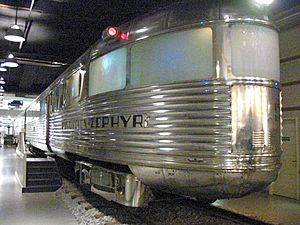
By the end of the 1930s, railroads introduced new car designs. In 1937, the Pullman Company made the first cars with roomettes. These were small, private rooms for single travelers. They had a window, a door, a fold-away bed, a sink, and a small toilet.
Passenger cars could now carry heavier loads. But the number of passengers did not increase much. Cars could not get wider or longer due to track limits. But they could get taller. So, railroads started building dome and bilevel cars to carry more passengers.
High-Tech Trains (1950–Present)
Car designs have stayed mostly the same since the mid-20th century. But new technology has improved existing car types.
Passenger travel in North America declined in the 1950s. However, commuter rail grew. North America's taller track clearances allowed for bi-level commuter coaches. These cars could hold more passengers. They became common in the U.S. in the 1960s.
While U.S. passenger rail declined, ridership grew in Europe. The Spanish company Talgo began experimenting in the 1940s. They developed technology that allowed train axles to steer into curves. This let trains go faster around curves. Later, mechanisms were added to tilt the passenger car. This helped counter the centrifugal force in curves, increasing speeds even more. Today, tilting passenger trains are common. Talgo trains are used on some U.S. routes, like Amtrak Cascades.
In 2016, the Department of Transportation approved a large loan. It was $2.45 billion to upgrade passenger train service in the Northeast. This money will buy 28 new train sets for the high-speed Acela train. It will also build new stations and improve tracks.
High-Speed Rail in the U.S.
Currently, there is only one operating high-speed line in the U.S. This is Amtrak's Acela Express between Washington, D.C., and Boston. It can reach speeds of 150 mph (240 kph) in some sections. New Avelia Liberty trains will soon reach 160 mph (260 kph). Eventually, parts of the line will be upgraded to 186 mph (300 kph).
California is building its own high-speed rail system, California High-Speed Rail. It is designed for speeds up to 220 mph (350 kph). The first section in the Central Valley is expected to open around 2027.
Major U.S. Railroads
- Amtrak
- BNSF Railway
- Canadian National Railway
- Canadian Pacific Railway
- CSX Transportation
- Kansas City Southern Railway
- Norfolk Southern Railway
- Union Pacific Railroad
Rail Connections with Neighboring Countries
 Canada – Yes, same track width (standard gauge). (No connection via Alaska)
Canada – Yes, same track width (standard gauge). (No connection via Alaska) Mexico – Yes, same track width (standard gauge)
Mexico – Yes, same track width (standard gauge)
How Railroads are Regulated
The United States Department of Transportation mainly regulates railroads. The Federal Railroad Administration handles safety. The Surface Transportation Board sets rules for rates, service, and mergers. States also regulate railroads, for example, through their own public utility departments.
|
See also
 In Spanish: Ferrocarril en Estados Unidos para niños
In Spanish: Ferrocarril en Estados Unidos para niños


